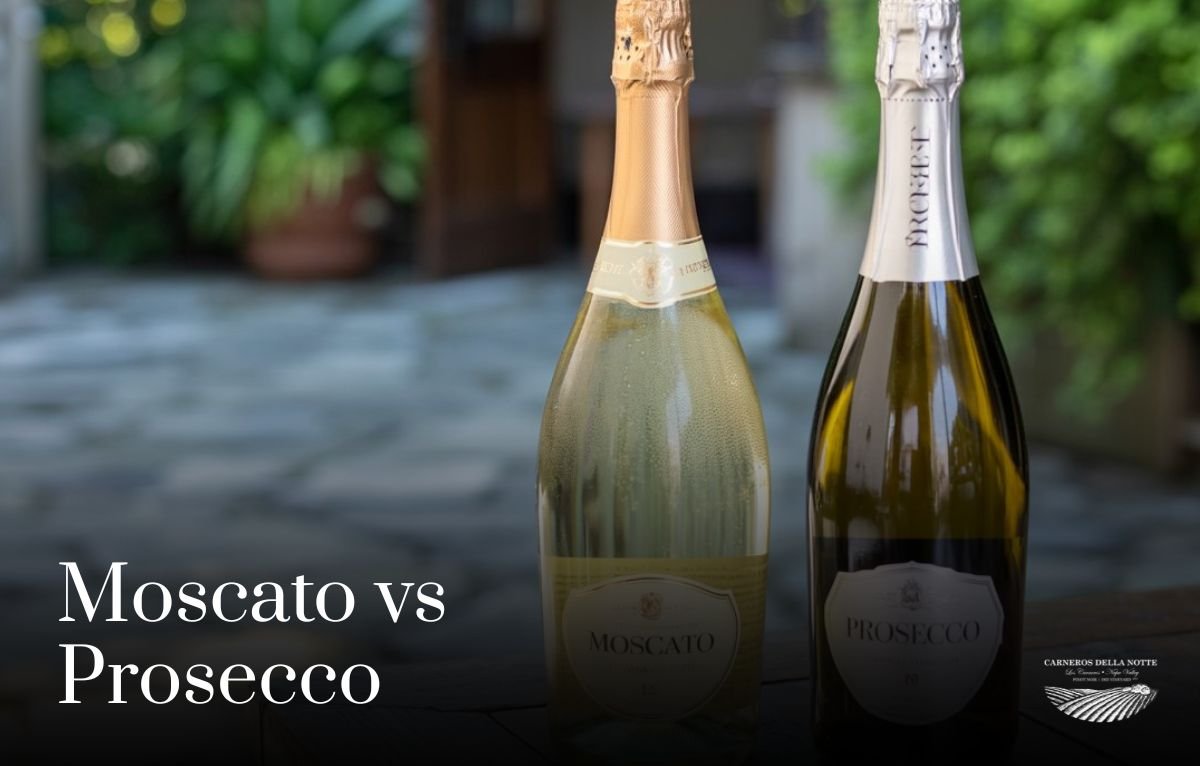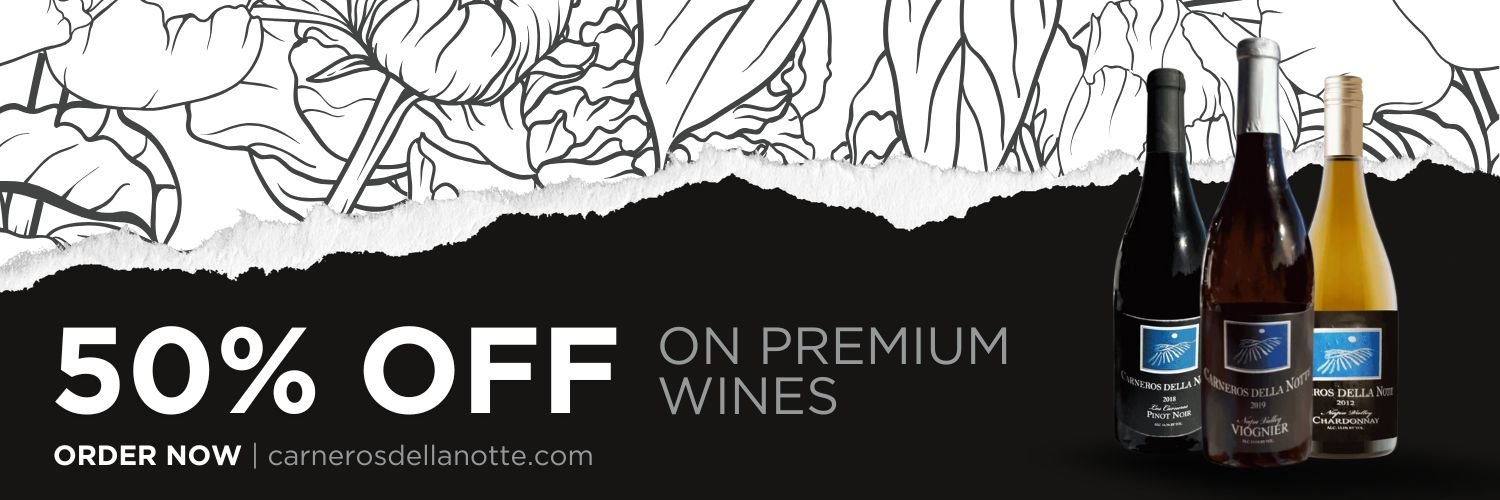If you are just beginning your journey into the world...
Read MoreThere’s no shortage of sparkling wines on the market, but two of the most popular options are Moscato and Prosecco.
Both are from Italy, both have bubbles, and both come in at an affordable price point. Still, they couldn’t be more different in taste, alcohol, and how they’re made.
If you’re standing in the wine aisle wondering which to grab, this moscato vs prosecco guide breaks it down in plain terms.
You’ll learn what makes each wine unique and when to serve them—so you’re never just guessing based on the label. Making informed choices is easy once you know what you’re looking at.
Not the Same Sparkle
Moscato comes from the Muscat grape, known for its floral and sweet aroma. It’s commonly grown in Italy’s Piedmont region, but versions of Moscato can be found in Australia, the U.S., and South Africa.
These wines are often produced with a quick fermentation process that keeps alcohol low and sweetness high. Winemakers usually stop the fermentation early, locking in sugar levels and creating a lightly fizzy texture.
Prosecco uses the Glera grape, primarily from Italy’s Veneto and Friuli regions. It’s regulated under Prosecco DOC or DOCG classifications, which follow specific standards to protect quality and origin.
Most Prosecco is made using the Charmat method, where the secondary fermentation happens in large tanks. This process preserves the wine’s bright acidity and helps achieve consistent bubbles. It also makes production more efficient, which is why Prosecco remains a great value.
The way these wines are produced plays a major role in the moscato vs prosecco comparison. Moscato is lightly fizzy and sweet. Prosecco offers more pressure in the bottle and a cleaner, more structured finish.
Taste Test
Moscato is known for its sweetness and easy-drinking profile. You’ll find notes of peach, orange blossom, apricot, and honeysuckle in most bottles. It’s often described as fruity and aromatic with a soft texture.
Alcohol typically ranges from 5% to 7% ABV, making it approachable for light occasions or daytime sipping. It’s the kind of wine that’s easy to enjoy even for those who don’t usually drink wine.
Prosecco leans toward dry or off-dry, depending on the label (look for “Brut” for drier options). Flavors include green apple, pear, citrus, and sometimes almond or white flowers.
With an average ABV of 10.5% to 12.5%, Prosecco has more bite and structure. The bubbles are more persistent too, thanks to the fermentation process.
It tends to feel more refreshing than sweet, which is why many people use it as a default choice for entertaining.
These core differences in taste and alcohol are central to understanding both wines. What you’re drinking it with—and how sweet you like your wine—can help you decide.
What to Eat with Each Sip
The style and sweetness of each wine affect how well it pairs with different foods.
Moscato is ideal for:
- Fruit-based desserts
- Soft cheeses
- Light brunch items
- Spicy dishes like Thai or Indian food
Its sweetness balances spice and enhances simple flavors without overwhelming them. For example, Moscato can tone down chili heat or add a fruity touch to goat cheese crostini. It also makes a nice choice for holiday desserts or lighter cake pairings.
Prosecco works well with:
- Fresh seafood like shrimp or oysters
- Appetizers with cured meats
- Fried dishes (think calamari or tempura)
- Hard cheeses like Parmesan
The crisp acidity in Prosecco cuts through fat and salt, making it a flexible option for more savory meals. You’ll often see Prosecco served with antipasti or seafood starters at Italian dinners. Its brightness helps refresh the palate between bites, which is key during multi-course meals.
Both wines are easy to match with food when you know what to expect from them. This makes it a relevant comparison not just for sipping but for planning meals and gatherings.
Daylight or Dinner Table?
Timing and setting matter. Moscato is best for daytime or casual settings. Its low alcohol and sweet profile suit warm-weather events, relaxed brunches, or any time you want a light drink. It’s also popular among newer wine drinkers.
If you’re hosting an afternoon garden party or need a low-key pour for a book club, Moscato fits right in.
Prosecco, with its more balanced character, fits a wide range of occasions. It’s great as a pre-dinner drink, during a toast, or served with a full meal. It’s also a go-to base for cocktails like the Mimosa or Bellini. You’ll often see Prosecco featured at weddings, Sunday brunches, and upscale picnics.
Choosing based on the moment helps you get the most out of each wine. This isn’t about which one is better overall, it’s about knowing what fits.
Price Tags and Shelf Space
Both Moscato and Prosecco are widely available, but Prosecco has a broader price range. You can find solid Prosecco under $20, but premium DOCG bottles from Italy can go higher depending on the producer.
Moscato tends to stay in the lower price range, which makes it a budget-friendly option without sacrificing drinkability.
Keep in mind that the wine’s origin affects both quality and price. Look for labels that show the DOC or DOCG regions for Prosecco, and check the back of Moscato labels for details on grape source and production method. Better labeling usually reflects more consistent quality and can help avoid overly sugary or flat versions.
Some winemakers in California are putting their own spin on both styles. It’s worth checking out domestic producers who focus on small-batch quality and true-to-varietal expression.
Quick Side-by-Side Recap
To make the difference easier to remember, here’s a simplified look at the key distinctions between Moscato and Prosecco:
Moscato
- Sweet and fruity
- Lower alcohol (5–7% ABV)
- Light bubbles
Pairs with dessert, brunch, or spicy food
Prosecco
- Dry to off-dry
- Moderate alcohol (10.5–12.5% ABV)
- Stronger, more persistent bubbles
- Pairs with seafood, appetizers, or rich dishes
This should give you a practical way to decide based on the situation or meal you’re planning.
Pick the Bottle That Fits Your Taste
The moscato vs prosecco question isn’t about which is better; it’s about what works for your taste and occasion. Moscato is fruity, sweet, and light, perfect for dessert or casual sipping. Prosecco offers crisp flavors and more structure, fitting a wider range of food and settings.
If you enjoy wines that are thoughtfully made and reflect the care of small-scale production, explore what Carneros Della Notte has to offer. Their wines bring together local expertise and high-quality winemaking practices that show in every pour.
Whether you’re pouring for guests or choosing for yourself, it’s always worth choosing wines that are clear in style and consistent in quality.
Latest blog & articles
Chardonnay for Beginners: A Friendly Guide to This Popular White Wine
Chardonnay wine stands as a pillar of sophistication in the...
Read MoreWhat Does Pinot Noir Taste Like?
If you’ve ever wondered what does Pinot Noir taste like,...
Read More





